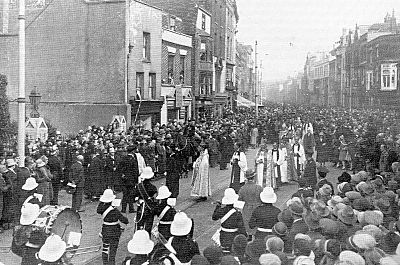
Neville Lovett was born on 16 February 1869 and was educated at Sherborne School and Christ's College, Cambridge. He was ordained in 1892 and served as priest at Clifton, Wymynswold in Kent (now called Womenswold), Bishop's Caundle in Dorset and Shanklin on the Isle of Wight. He was Rector of Farnham, Surrey from 1908 to 1912 when he became Rector of St. Mary's, Southampton. He was inducted as Vicar of Portsmouth on 6th February 1925 and instituted as the first archdeacon of Portsmouth on 7 March 1925.
His first task was to oversee the foundation of the new diocese of Portsmouth, to which end he set up an executive committee, acquired No. 60 High Street as the diocesan offices and located a suitable home for the new bishop in Fareham. The one thing he didn't do was become involved in the debate over whether St. Mary's, Portsea or St. Thomas's, Portsmouth should become the new cathedral. Once the decision went in favour of the latter, albeit on a provisional basis, he set about making it suitable for the diocese. In the long run the church would have to be enlarged if it's new found status was to be confirmed but the immediate needs were changes to the seating, a new vestry and a bishop's throne.
The Diocese of Portsmouth officially came into being on 1 May 1927 so all that remained was the appointment of a bishop. The Prime Minister Mr. Baldwin wrote to Neville Lovett informing him that his name would be put forward to the king and after a short consultation with colleagues he accepted and was consecrated in Westminster Abbey on 25th July 1927. St. Thomas's was hallowed as a cathedral church on 4th October 1927 and two days later Lovett was enthroned therein. He was 58 years old at the time.

Shortly before these events Portsmouth had conferred upon it the dignity and status of a city with its chief citizen styled as Lord Mayor. The holder of this office at the time Lovett became bishop was Alderman Frank Privett. The new bishop was very aware of the need to work with the Lord Mayor, especially as he was not familiar with the city or its people, and he was fortunate in finding such an accommodating mayor as Frank Privett. At the same time he understood the importance of the navy to the church and he helped forge a triumvirate of Lord Mayor, Commander-in-Chief and Bishop which came to represent the spirit of Portsmouth in the run up to and during the Second World War.
The issue of whether St. Mary's Church would eventually take over some or all of the functions of the cathedral had not entirely vanished and the only way it would do so was if St. Thomas's was extended so that it could accommodate larger ceremonial occasions. In 1932 Lovett asked the architect Sir Charles Nicholson to prepare plans for the enlargement of the nave. He produced three plans and a final decision was reached at a meeting in January 1933. Tenders for the work were invited in April 1935, and thanks to gifts from Sir Heath Harrison, and, after his death in 1934, from Lady Harrison, building commenced in 1936, but in May that year Neville Lovett was obliged to surrender responsibility for the project when he was appointed Bishop of Salisbury.
Neville Lovett remained at Salisbury until 30 April 1946 when he retired to Meon Lea in Droxford. He died on 8 September 1951. He had married Evelyn Block in 1894 and they had five daughters. She died in 1937.
Additional Information
Away from his formal ecclesiastical environment Neville Lovett, in 1909, produced a historical tableaux describing the history of Farnham since the Roman period which was played in the newly-built church house. This representation was developed as the "Farnham Historical Episodes" performed in the Farnham Castle ground in 1910. In 1912 Lovett wrote another historical pageant, The passing of the Bailiff: a play of Georgian Farnham: recalling certain incidents there in the year 1793 (circa) and the people who took part therein. This was successfully performed and the text published.
One aspect of Lovett's life which is infrequently mentioned was his membership of the Freemasons. Perhaps this is because there is little evidence commonly available. However, in "Freemasonry in Hampshire and the Isle of Wight" by F.D. Laugharne, the following text appears; "His Majesty King George V chose to be the first Bishop of Portsmouth, W.Bro. Neville Lovett, P.P.G. Chaplain". This is followed by a reference to the Brethren donating the cost of a new Chapter Room in St. Thomas's which was handed over by the Provincial Grand Master to the Bishop at a ceremony attended by many members of the Craft on 11th October 1927.
The Bishop responded "Right Worshipful Provincial Grand Master, I accept gratefully this that has been done by my brethren of the Craft and I deliver it to our brothers G. Grant and H.A. Dart the Wardens of the Cathedral Church who have ward and charge of the building".
A second ceremony took place afterwards which related to the stone stairway by which the choir entered for Divine Service, the cost of which was defrayed by members of the Thomas à Becket Lodge of Mark Master Masons, whose marks are engraved on the steps leading to the North Gallery of the Cathedral.
It is unclear whether the Chapter Room was ever actually finished but it is generally accepted that it was intended to be where the organ loft is now placed. This is partly because the organ loft has a very fine parquet floor which one would not normally expect. It is known though that the stairs and their masons marks do still exist.
REFERENCES
"Forever Building" Chapter Six by Terry Louden
"Freemasonry in Hampshire and the Isle of Wight" by F.D. Laugharne
Wikipedia
Memorials in Portsmouth